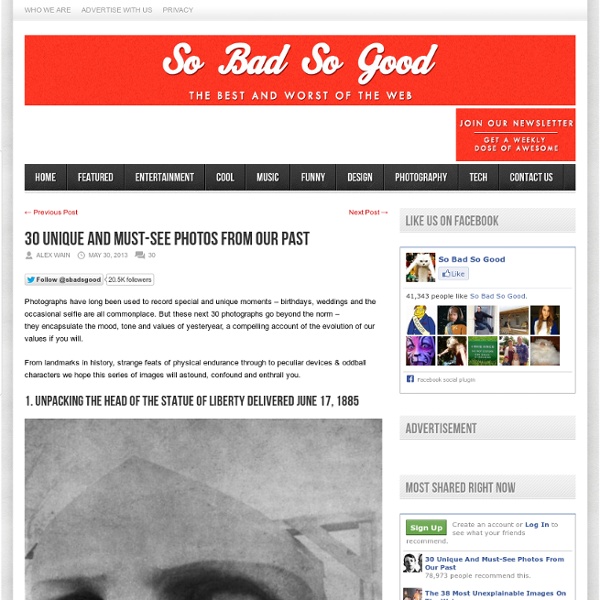



Film Blog | All about movies, current and upcoming Ben Zank's Photostream Realistically colorized historical photos make the past seem incredibly real [36 pictures] Over the last couple years, an increasingly popular trend online has been to create and share colorized photos from history. Artists such as Jordan Lloyd, Dana Keller and Sanna Dullaway take intriguing old black-and-white photos and bring them to life with color as if they’d been taken only yesterday. Here are some examples… Unemployed Lumber Worker and His Wife, circa 1939 Testing the Hydrogen Bomb London, 1945 Hindenburg Disaster, 1937 Japanese Archers, circa 1860 View from the Capitol in Nashville, 1864 Audrey Hepburn Albert Einstein in Long Island, 1939 Nazi Minister of Propaganda Joseph Goebbels scowls at a Jewish photographer, 1933 Baltimore Slums, 1938 British Troops Board Their Train for the Front, 1939 Oscar II, King of Sweden and Norway, 1880 Walt Whitman, 1887 Mark Twain, circa 1900 Charlie Chaplin, 1916 Elizabeth Taylor, 1956 Country store, 1939 Washington D. Charles Darwin, 1874 Abraham Lincoln, 1865 Theodore Roosevelt Louisville, Kentucky, 1937 Big Jay McNeely, Olympic Auditorium, 1953
Anamorphic Sculptures - Fubiz ™ Reprenant le principe de l’anamorphose permettant une déformation d’une image qui se recompose depuis un point de vue voulu par l’auteur, Jonty Hurwitz nous propose des sculptures magnifiques qui ne donnent pas la même représentation selon le point de vue. De superbes réalisations à découvrir dans la suite. NOVA Can Wind Turbines Make You Sick? Residents living in the shadows of wind turbines say the sound is making them sick. But so far the science isn't there. From NOVA Next | Jun 27, 2018 Thirty Years Ago Today, Global Warming First Made Headline News On June 23, a NASA climate scientist, James Hansen, told a U.S. From NOVA Next | Jun 23, 2018 New Middle Eastern Particle Accelerator’s Motto is “Science for Peace” In a region in turmoil, an unprecedented joint venture of scientists and policymakers is working together on Jordan’s new particle accelerator under the motto "science for peace." From NOVA Next | Jun 21, 2018 Psychological Damage Inflicted By Parent-Child Separation is Deep, Long-Lasting Here's what happens in the brain and the body when a child is forcibly separated from his or her parents.
ISO 12233 Test Chart The ISO standard for measuring resolution of “electronic still imaging”" cameras is 12233, available only from the International Standards Organization for only 116 Swiss Francs (about $US93 as of this writing) and under copyright protection. But the design of the test chart seems not to be protected; its description has been available on the Web in an Excel spreadsheet. I have semi-manually converted this to an Adobe Illustrator file which is displayed here. Click here for a printable PDF version. In principle, you should be able to print this chart and perform resolution tests on your camera. Advanced resolution tests It seems that most folks, for example Imaging Resource, use this chart for visual assessment of resolution, but it's designed to do more. Buying a real ISO 12233 chart The proper way to perform these tests is to order both the ISO standard and a properly-made test chart.
TFL Etiquette Posters Made More Honest TfL’s ‘Travel Better London’ campaign, aims to highlight the anti social behaviours which ruin our journeys. We think they could have gone further. By @technicallyron ► Our NEW Android friendly app - brings you our latest exclusives PLUS the funniest videos and pictures from the internet DAILY - in one place. ► Bargain Mug Of The Week from The Poke Shop Aakash Nihalani “Sum Times”, interventions by tape artist Aakash Nihalani. aakashnihalani.com Big Bang: Abstract Photograms Created by Exposing Photo Paper to Fireworks What kind of imagery results when you mix photo paper and fireworks? That’s a question photographic artist Ross Sonnenberg has been exploring for the past few years. He creates one-of-a-kind camera-less photograms that look like abstract images of galaxies, but are actually random and colorful patterns created by the light of firecrackers. He has been creating images for two projects: Color Bang, which features this technique done on smaller pieces of photo paper, and Long Bang, which uses the technique on much grander scale. Here’s a video in which Sonnenberg introduces his technique: He writes, I have always been fascinated by the planets and stars, looking through telescopes and wondering what these far off places might look like. Here are some of the photos in the Color Bang series: You can find more of these images over on Sonnenberg’s website. P.S. Image credits: Photographs by Ross Sonnenberg and used with permission
40 Maps They Didn’t Teach You In School ! – Tunisme No more geography lessons based on just one and the same world map! Rediscover our world through these 40 Maps.The Most Famous Brand From Each State In The US Image credits: mapsontheweb.tumblr.com Red Hair Map of Europe Image credits: imgur.com Most Popular Sports in the World Breast Sizes Relating to Countries Image credits: targetmap.com Political World Map as Pangea 200-300 Million Years Ago The World According to Americans Image credits: alphadesigner.com Most Used Web Browser World Map (2012) Image credits: saint-tepes.deviantart.com Map of Countries Officially Not Using the Metric System Image credits: wikimedia.org The Penis Size Worldwide Map of the Most Common Surnames in Europe Map of Countries Most and Least Welcoming to Foreigners World Map of National IQ Scores Beer Names in Different European Languages Freedom of Press Most Consumed Alcoholic Beverage by Country Image credits: chartsbin.com A World Map that Inverts Land and Sea Worldwide Driving Orientation Prevalence of Obesity